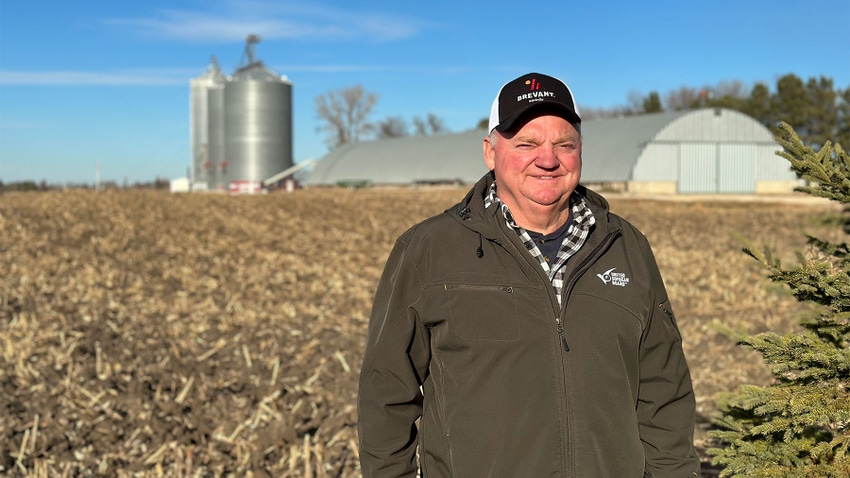
Lawrence Sukalski and his family grow more corn than soybeans on their Martin County, Minn., and Kossuth County, Iowa, farm ground, but that could be changing soon.
“People predict that within five years, we will need to grow 10 [million] or 12 million more acres of soybeans to meet the growing demand,” Sukalski says, “and that will have to come from corn or wheat.”
Location is the main factor for the Sukalskis current cropping system, with Martin County’s strong hog production and proximity to two ethanol plants.
“Livestock, trade and biofuels have made the price of soybeans,” Sukalski says. The nation’s push to lower carbon emissions and the role low-carbon fuels play in reaching that goal will increase the need for more biodiesel production.
Sukalski, Fairmont, Minn., has recently been elected to his third of three terms on the United Soybean Board and is the lead on the infrastructure and connectivity working group on the Demand Action Team. In early December, Sukalski was also elected to the USB Executive Committee.
“On the demand side, we deal with products after the soybeans have been crushed — mainly the meal and the oil,” he explains.
Soybean meal going to livestock is a large market for U.S. soybeans. “We don’t have any problem getting rid of our meal. … We’ve got really good meal,” Sukalski says.
Acting as a voting member of Clean Fuels Alliance America, Sukalski has a finger on the pulse of soybean demand for biodiesel. Say what you will about California’s impact on the rest of the country, but “they are really into low-carbon fuels,” he says. “They use as much biofuels as the other 49 states put together, so it’s a collaborative effort to get biodiesel, renewable diesel and sustainable aviation fuels produced.”
Today’s soybeans are 20% oil, and Sukalski says some people predict that 20% will account for more than half of the price of the soybean. “There’s probably been 10 [million] to 12 million more bushels of crush made in the last few years or that are going to get made,” he says. “And that’s all because of the biodiesel demand and the renewable diesel demand.”
This shift toward greater demand for soybeans more than likely will be reflected on the farms run by Sukalski and his wife, Diane, and his brother Harlan. He and Diane’s adult children — Jacob, Andrew, Kristina, Michael and Suzy — help on the farm. “There are times we have five machines going on the weekend during harvest,” Sukalski says.
Though the Sukalskis do not raise pigs, he sees his hog-raising neighbors benefiting if there is a boost in soybean acres. “If we raise more soybeans for the oil, we should have more meal, so hog producers should have cheaper meal,” he says. “It’s been a lot of fun to see all this expansion in oil.”
More than feed and fuel
On top of domestic demand for soybeans, exports remain an important piece to the market puzzle, and Sukalski says wise use of growers’ checkoff dollars can go a long way in improving the infrastructure to help get beans into markets.
“When the Mississippi River gets low, there are problems. Sometimes they have to load the barges to 50%, and that really slows things down,” he says. USB’s investment in research, analysis and design pushed funding from the U.S. Army Corps of Engineers and the Louisiana Department of Transportation and Development to dredge the lower Mississippi River. USB estimates this will allow barges to deliver an additional 500,000 bushels per ocean vessel, creating the potential to add $461 million in realized value for U.S. soybean farmers.
Ensuring that U.S. soybeans can access valued markets goes beyond dredging the lower Mississippi, and Sukalski says that means expansion of the Grays Harbor terminal in Washington that will enable increased soybean meal exports from 3 million to 6 million metric tons.
He adds that representatives of Minnesota Soybean and other neighboring states “are trying to jump-start the Port of Duluth to start going out that way” through the Great Lakes and the St. Lawrence Seaway.
“We have got to have some sort of a plan when the infrastructure has problems, and we could have a train strike at the same time,” he says.
Greater good
Sukalski is one of four Minnesotans on USB, joining Gene Stoel, Tom Frisch and Patrick O’Leary. Even with that strong North Star State contingency, they have to look beyond state borders for what is best for the U.S. soybean farmer, regardless of their origin.
“The No. 1 thing that we’re trained right away is, you might have your state projects or whatever, but you’re looking for the benefit of everything,” Sukalski says. “If there’s a better return on investment someplace else, that’s what you’re looking at. So, they try to train us to not look out our back door.”
Responsibility with soybean growers’ checkoff dollars is one Sukalski takes very seriously, knowing he’ll take heat from Minnesota soybean producers for approving projects that may not directly benefit growers here. “We might do something that benefits the southern producer,” he says, “but then there are the high-oleic soybeans that are alive and well in Minnesota.”
Regardless of a suggested project’s direct beneficiaries, Sukalski aims to have every voice be heard so checkoffs dollars can have the biggest impact — and he says it is a big impact.
“Checkoff is the best we’ve got going for us,” he says. “We’re seeing $12.34 in return value for every checkoff dollar invested. I’m proud of what it’s accomplished, and I take that very seriously.”
Read more about:
Soybean CheckoffAbout the Author(s)
You May Also Like






